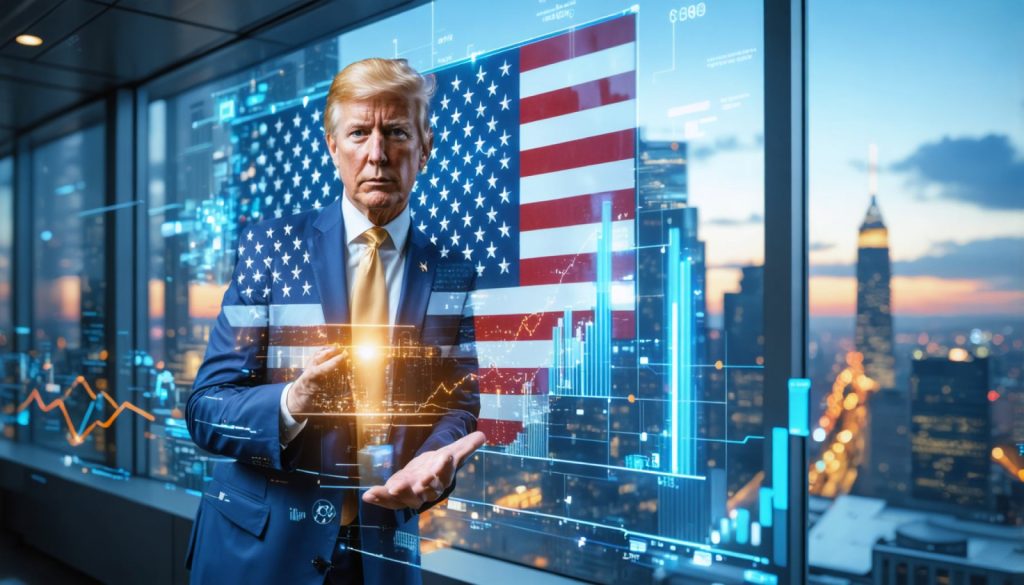
- The U.S. government has exempted key electronic components like smartphones, laptops, and semiconductor chips from tariffs, relieving Silicon Valley tech giants.
- This policy change by the Trump administration removes financial burdens, primarily affecting imports from China, and provides economic relief to tech companies.
- Apple benefits significantly from this exemption, maintaining pricing stability for its iPhones, which are predominantly manufactured in China.
- Semiconductor companies such as Nvidia and TSMC find new opportunities for growth, as supply chain costs reduce without the tariff impact.
- The administration promotes domestic innovation, with tech giants investing in the U.S. economy, notably Apple’s $500 billion economic injection and job creation plan.
- The emphasis on reducing reliance on China encourages the development of a robust manufacturing ecosystem within the United States.
As the digital smoke clears from the relentless trade skirmishes that gripped America and China, a shimmering oasis emerges for tech giants. The U.S. government’s decision to exclude several key electronic components and devices from crippling tariffs has sent tremors of relief rippling through Silicon Valley.
Picture this: smartphones, laptops, and semiconductor chips—vital arteries of the modern digital age—dancing free from the shackles of tariffs that once threatened to inflate their costs and shrink their markets. This policy pivot, declared with precision by the Trump administration, effectively carves these essentials out from the punitive taxes that previously loomed over imports, notably those funneled in from Chinese production lines.
For companies in the tech sector, this reprieve represents a golden ticket, especially when considering the turmoil endured since April 2. On that fateful day, the declaration of sweeping tariffs laid siege to Silicon Valley, wiping away a staggering $2.1 trillion in market value. A bleak tableau painted over computer screens brightened somewhat when, in a deft strategic move, Trump put tariffs on a temporary hold for countries beyond China. This adjustment managed to whittle the loss down to $644 billion, easing some of the collective panic.
Yet, it is the latest exemption that has unleashed a new wave of optimism. Apple, perched atop the tech world with its ubiquitous iPhones—a luxury crafted primarily on Chinese soil—stands to gain enormously. The absence of tariffs lights a path lined with stability for Apple, ensuring prices remain palatable for consumers and helping to secure Apple’s dominant market share.
Beyond the realm of smartphones, semiconductor companies—enduring the silent conquest of chips—find new ground to flourish. With equipment pivotal to semiconductor production also navigating past the tariff barricades unscathed, firms like Nvidia and TSMC can set their sights on innovation and growth, free from the specter of supply chain hikes.
The momentum does not stop at financial balance sheets. Expecting affirmative nods from policy makers, giants of the technology cosmos like Apple, TSMC, and Nvidia are encouraged to foster a robust domestic industry. Recent investments echo this sentiment. Apple, echoing pledges scripted in February, aims to inject $500 billion into the U.S. economy and create a rich tapestry of 20,000 jobs in the coming years—a sequel to their $350 billion commitment during Trump’s initial stride through the White House.
The tech tour de force is spearheaded by visions of homegrown innovation as directives from the White House emphasize a burgeoning manufacturing ecosystem within U.S. borders. In a declaration underscored with determination, White House Press Secretary Karoline Leavitt reiterated the administration’s commitment to curtailing reliance on China for critical technology, turning a prescient eye toward America’s own soil.
As these tectonic shifts unfold, a takeaway emerges with crystal clarity: The interplay between policy and technology remains a pivotal narrative of our time, dictating not only how industries thrive but also how nations lay the foundation of their future economies. In this dance of diplomacy and commerce, the U.S. appears poised to leap forward, embracing a horizon where technology and economic sovereignty stride hand in hand.
Tech Giants Get a Break: U.S. Tariff Exemptions Ignite New Hope in Silicon Valley
Overview: Navigating the Tariff Terrain
In the aftermath of tensions between the U.S. and China, a new policy exempting key electronic components from punitive tariffs has injected hope into Silicon Valley. This decision by the U.S. government offers a reprieve to tech giants, allowing for the unimpeded import of items like smartphones, laptops, and semiconductor chips from China. Previously looming tariffs had posed a threat to increase costs and reduce market accessibility for these essential digital products.
The Impact on Tech Giants
– Apple: With most of its flagship iPhones manufactured in China, Apple is directly benefited by the tariff exemptions. The move ensures that iPhone prices remain competitive in international markets, helping Apple maintain its market position.
– Semiconductor Firms: Companies such as Nvidia and TSMC breathe a sigh of relief as import duties on key semiconductor components are lifted. This change prevents potential supply chain disruptions and allows them to focus on innovation.
– Investment in U.S. Economy: In light of these recent changes, companies are encouraged to bolster domestic operations. Notably, Apple plans to add $500 billion to the U.S. economy and create 20,000 jobs, supporting the push for a robust manufacturing ecosystem in America.
How-To Steps for Tech Investors
1. Diversify Investments: While tech stocks may be buoyed by tariff exemptions, diversifying your portfolio can manage risk if trade tensions shift.
2. Monitor Policy Changes: Stay informed on policy adjustments between the U.S. and China, as these can influence market dynamics.
3. Invest in Innovation: Focus on companies prioritizing research and development, ensuring they remain competitive and forward-looking.
Real-World Use Cases
International Technology Markets
– With tariff relief, American companies can price their products more competitively in global markets, increasing their share abroad.
– Investment in domestic manufacturing can create a ripple effect, boosting ancillary industries like logistics and local supply chains in the U.S.
Industry Trends
– Relocation of Production: Expect shifts in manufacturing locations as companies explore alternatives to reduce dependency on China.
– Focus on Renewable Energy: As tech companies invest heavily in the U.S., there’s likely to be an increased emphasis on sustainable practices and renewable energy sources to power new facilities.
Pros & Cons Overview
Pros
– Cost Stability: Tariff exemptions help maintain price stability for consumers and companies.
– Encourages Domestic Growth: Policy directions to reduce dependency on China foster U.S.-based innovation and job creation.
Cons
– Uncertainty Remains: Trade policies can change rapidly, creating unpredictability for long-term strategy planning.
– Potential Supply Chain Adjustments: Companies may incur short-term costs while transitioning part of their operations back to the U.S.
Actionable Recommendations
– Stay Informed: Regularly review trade policy updates related to U.S.-China relations.
– Invest in U.S. Infrastructure: Companies can benefit from bolstered infrastructure as they realign operations domestically.
– Adopt Sustainable Practices: Embrace renewable energy and sustainable manufacturing to align with potential future regulatory trends.
Conclusion
The U.S. government’s decision to exempt certain tech components from tariffs has significant implications for the technology industry, offering relief and encouraging domestic growth. By reducing reliance on Chinese manufacturing, nurturing innovation, and fostering job creation, the stage is set for a robust future for American tech giants. For more insights into the evolving tech landscape, visit the Apple website and explore real-time developments and strategies shaping the industry’s path forward.



